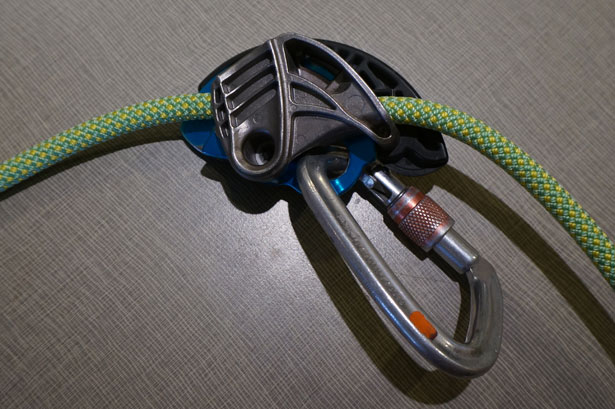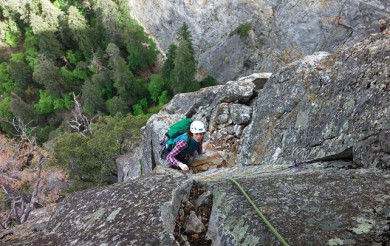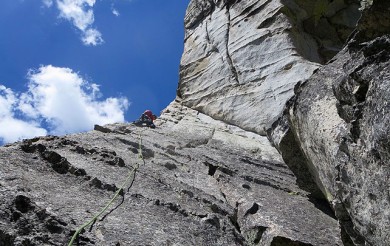Trango Vergo Review
(Editor’s Note: I love the Petzl GriGri. It’s been my main belay device for the last 15 years. To me, it’s the gold standard for assisted-braking devices. And as such, any new device in this category should be compared directly to the GriGri for an honest look at how it stands up.)
The GriGri was hands down one of the most important gear developments in the history of climbing. Since its inception, a number of companies have tried to offer devices that performed in a similar fashion, often trying to address a perceived drawback of the original. Over the years, I’ve had a chance to use many of them, and in my opinion, they generally fall short. No one wants to learn a complicated new technique, or have a lowering method that’s jerky and unreliable, or pay a lot more money for it. If you are going to compete with the belay device that the majority of the climbing population knows and loves, your product can’t be almost as good, it has to be equal to or better than the gold standard. You need platinum, baby!
Trango’s latest belay device, the Vergo, is the strongest offering I’ve seen in the assisted-braking device category for a long time. While some might think it’s simply a redesign of the Cinch, in talking with the folks at Trango they explained that they basically started over with the Vergo, even bringing in folks with PhDs in ergonomics to build a tool that would work as well as it could for its intended purpose, in the safest way possible.
The biggest issue with the GriGri, as they see it, is that in order to feed slack to a lead climber, you are in essence overriding the device. You prevent the cam from closing so that you can pull rope through. And while if used correctly, errors are unlikely, the reality is that there are accidents every year from people using them wrong. Trango approached building the Vergo with the concept of “what if the best way to use the belay device was also the safest?” The result is a device that feeds easily, locks up incredibly well, lowers smoothly and weighs nearly the same as the GriGri 2. Let’s look at each of those aspects in turn.
Feeding slack was very easy. I watched the product video once to make sure I wasn’t going to kill myself using it the wrong way, then went out and used it on a week-long trip. It took almost no time to get the hang of feeding slack, and I was actually surprised to find that, for me, it fed rope easier than a GriGri. The technique required is unique to the device, but took very little time to master. You feed out to the side, which allows the rope to travel in as straight a line as possible through the cam, but you aren’t holding anything open. If the lead climber falls while you are mid-feed, the cam will easily engage. Also, climbers with smaller hands that tried out the Vergo felt like it was easier for them to use than a GriGri, a problem I see often teaching students with smaller hands how to lead belay with GriGris.
As far as the cam goes, it locks up very quickly and gave me total confidence in the device. I’ve been using the Vergo for a lot of route development this summer and while rope soloing with it, it gave me more peace of mind than using the GriGri for a similar task. Friends who I’ve let use the device also commented on how quickly the cam engages.
One of the things I never liked about the Cinch was the handle. It’s so small, lowering always felt like a pain. The handle on the Vergo is large and easy to use, and allows you to dial in the proper lowering speed easily, though I don’t think it’s quite as smooth as a GriGri.
On the weight front, it’s 25g heavier than the GriGri2 (195 g versus 170g), which is less than one ounce for our imperial friends. Certainly not enough for me to care about the difference.
There are two main criticisms I have of the device. One, because the steel cam is exposed, versus being encased in the device like with the GriGri, it gets hot while lowering. Even when lowering a climber only 30 feet, the device was noticeably warm/hot. Not a deal breaker, but something to be aware of. The second is that the recommended way to clip the device to your belay loop (see this at about 30 seconds into the video below) is a bit counterintuitive, as you essentially clip it upside down, which introduces an extra twist and improves the ability of the device to lock onto the rope (I know some folks that use their GriGri like this also). Personally I have been using it in this configuration maybe half the time, as it seems to work just fine clipped on in a more natural orientation.
I’ve been using the Vergo for several months now, and one of the reasons Trango sent me one early was because they knew I’m a huge GriGri fan and very skeptical of competitors. Before the Vergo I would have said there were some OK alternatives, but nothing I had tried would ever replace the GriGri for me. That has changed with the Vergo, as much as it pains me to say anything negative about my beloved GriGri, and there are plenty of days when it’s the only device I take with me to the crag.
The Vergo combines ease of use, safety, weight and price in a package that makes it one of the best assisted-braking devices on the market. If you have the chance to try one, don’t miss out, I bet you’ll be pleasantly surprised, just like I was.
Retail: $89.95
Weight: 195g
Rope diameters: 8.9mm – 10.7mm
More information and tech specs can be found on the Trango website.
Disclaimer: Wait! Before you go handing over your credit card number, ask yourself, do you really need to buy more new stuff? If so, this product is worth a look. In the spirit of full disclosure, it was provided to SplitterChoss.com for the purpose of reviewing. Don’t worry, though, our integrity can’t be bought!
7 Responses to Trango Vergo Review
Bulldog Creek Dog Walk (IV WI 4+)
Hayden Carpenter and Tom Bohanon recently repeated an obscure ice climb on the south side of Mt Sopris. Given a brief mention in Jack Robert’s ice guide, Bulldog Creek Walk is described as being 100 meters of WI 4. What they found was seven pitches of ice in a remote setting that makes for one […]
Connect with Us


















Thanks for the great review. Funny, I was looking at the first photo and thought, “hmm, looks like it’s clipped upside down on the belay loop” and then read your explanation later. Do you orientate it “upside down” while rope-soloing/route developing?
Nope, I didn’t, I was using it in “normal” orientation and it worked fine.
great impartial review, thank you.
Is the kink angle the same as the Cinch. I like the Cinch for many reasons, but one of them is I can clip and unclip it from a weighted rope due to the slight kink angle.
Not totally sure, I know they said they did change the geometry of the device so it might be different than what you are talking about. They could probably tell you.
Thanks for putting it through its paces.
If you are belaying from the top, direct off the anchor, and go to lower your climber, is there a redirect procedure like that used with a Grigri? Was this something you tried?
I actually didn’t use it for multipitch, I’m a fan of the ATC-Guide for belaying from the top. I don’t use my GriGri for this, since you can’t actually go hands free with it like you can with a guide-mode belay device. My hunch is it would work pretty well.